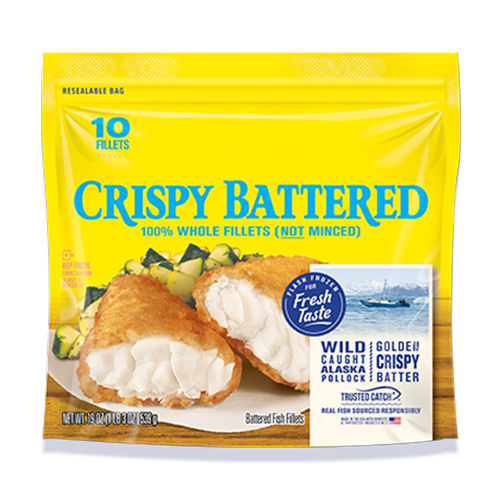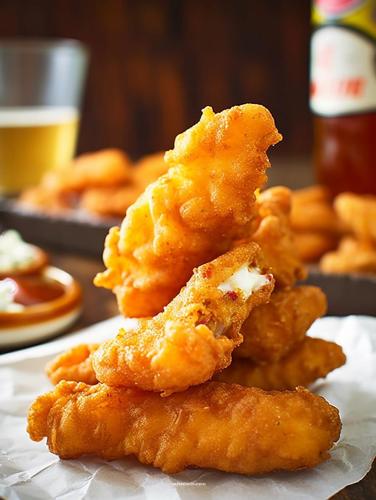MAIN DISHES
Battered Fish
Battered fish is a popular dish consisting of fish fillets coated in a seasoned batter and deep-fried until crispy and golden brown. The type of fish used may vary, but common choices include white fish such as cod, haddock, and pollock. Battered fish is popular in many cuisines, most notably in British cuisine as a component of the quintessential fish and chips meal, and it is enjoyed by families and individuals worldwide.
The batter used for fish can be made from various ingredients, including flour, cornstarch, and sparkling water or beer, which adds lightness and a distinctive taste. The seasoned batter creates a protective layer that seals in the moisture, helping to retain the fish's natural flavors and tender texture during cooking. Served hot alongside condiments such as tartar sauce, mayonnaise, or malt vinegar, battered fish makes for a satisfying and flavorful meal.
54%
CARBS
28%
FAT
18%
PROTEIN
243 Battered Fish Products
Gorton's Beer Battered Fish Fillets - 10 CT
Great Value Crispy Battered Fish Fillets
Gorton's Classic Crispy Battered Fish Fillets - 10 CT
Gorton's Crunchy Breaded Fish 100% Whole Fillets, Wild Caught Alaskan Pollock with Crunchy Panko Breadcrumbs, Frozen, 10 Count, 19 Ounce Resealable Bag
Van de Kamp's Beer Battered Fillets
Gorton's Fish Sandwich Breaded Fillets - Frozen
Gorton's Crunchy Breaded Fish Fillets Club Pack - Frozen
Mrs. Paul's Crispy Beer Battered Fish Fillets, Frozen
Van de Kamp's Crispy Battered 100% Whole Fish Fillets, Frozen
Wegmans Breaded Haddock Fillet
27 Recipes for Battered Fish
Used In 8 Recipes
Battered Fish FAQ
Battered fish, while delicious, can be a challenging dish for some home cooks. The most common issues arise from the battering and frying processes. Firstly, achieving a light, crispy, and well-seasoned batter that sticks to the fish properly can be tricky. Factors including batter consistency, temperature of the batter and the oil, and the technique used for applying the batter can all impact the end result. When frying, maintaining the right temperature is vital, as too high can lead to over-browning or burning, while too low can result in a greasy, soggy batter. Additionally, the selection and preparation of the fish is also important.
To get the most out of battered fish, choose fresh fish with firm flesh, ensure the beer or sparkling water is ice-cold and the oil is hot (around 375°F), coat the fish with flour before dipping into the batter for better adhesion, and consider double frying for extra crispiness. Also, don't overlook the importance of well-seasoned batter – it's not just about the fish, the batter should be flavorful in its own right!
Some little-known tips include adding a teaspoon of baking powder to the batter for added lightness, using a deep-frying thermometer to maintain the perfect oil temperature, and laying the battered fish into the oil gently to prevent splashing and uneven cooking.
Why does my batter not stick to my fish?
How do I get a light and crispy batter?
What's the best type of fish to use for battered fish?
Why is my battered fish greasy or soggy?
Can I use a different liquid to mix the batter?
Can I bake battered fish instead of frying?
How do I avoid fishy flavor in my battered fish?
What's the best way to coat the fish in batter?
My fish cooks unevenly, what am I doing wrong?
What is double frying and how can it help my battered fish?
Expiration & Storage Tips
When does Battered Fish expire?
Battered fish, when kept in a refrigerator, generally has a shelf life of about 1-2 days when kept in an air-tight container. If the fish was deep-fried at home and leftovers are available, it should be consumed as soon as possible, ideally, the same day. If you have store-bought frozen battered fish, you can typically keep it in your freezer for about six months from the printed date on the packaging. However, once you’ve opened the package, or have cooked the fish, try to consume it immediately for best quality and safety.
How do you tell if Battered Fish is bad?
There are a few signs you can watch for to tell if the battered fish has gone bad. First, there is the smell. Fresh fish has a mild smell; when it starts to become spoiled, it will get a strong, sour and unpleasant fishy smell. This applies even after the fish has been battered and cooked. Secondly, if the fish starts to appear pale and dry, or if it has a slimy texture, it's probably not good to consume. Lastly, look for any discoloration in the batter or mold, a clear sign that it's time to toss it away.
Tips for storing Battered Fish to extend shelf life
Here are some suggestions for storing battered fish to prolong its freshness:
• Always store leftovers in an airtight container in the fridge to keep out bacteria and odors from other foods.
• Allow cooked battered fish to cool down before putting it in the refrigerator. Rapid cooling can help prevent the growth of bacteria.
• If you've bought frozen battered fish, keep it in the freezer and take out only as much as you'll cook and consume immediately. Refreezing thawed fish can cause texture and quality degradation.
• To freeze homemade battered fish, allow it to cool after cooking, then wrap each piece individually in cling film or foil and place them in a heavy-duty freezer bag.
• When defrosting, it's best to let the fish thaw in the refrigerator overnight. This slow, controlled defrosting process helps keep the fish safe from bacterial growth and maintains its texture.
EXPIRES WITHIN
19 - 29
MONTHS
Health Info
Macros
33g
CARBS
16g
FAT
12g
PROTEIN
Allowed on these diets
LOW FAT
HIGH CALCIUM
LACTOSE FREE
Contains these allergens
WHEAT
FISH































